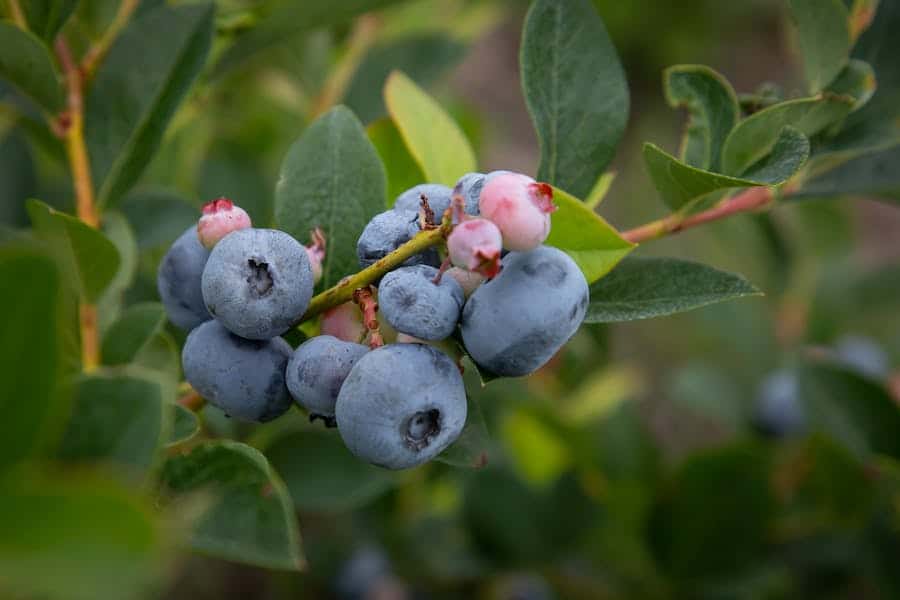Huckleberries, those delectable little jewels of the wild, have captured the fascination of nature enthusiasts, foragers, and culinary connoisseurs for generations. Recognized for their sweet-tart flavor and versatile applications, these small berries hold a special place in the hearts of many. However, before embarking on a huckleberry-picking adventure or attempting to incorporate them into recipes, one must first answer the fundamental question: “What does a huckleberry look like?” In this comprehensive guide, we will dive into the world of huckleberries, exploring the diverse species, physical characteristics, habitats, and practical tips for identifying these berries. Whether you’re a novice or a seasoned forager, this article will equip you with the knowledge needed to confidently identify huckleberries in the wild and harness their culinary and cultural significance.
What Does A Huckleberry Look Like?
Huckleberries are small, round berries with colors ranging from deep purple to dark blue or even red. They typically measure around 1/4 to 1/2 inch in diameter and have a smooth, shiny skin. Huckleberry leaves are typically oval with serrated edges and may be evergreen or deciduous, depending on the species. Clusters of huckleberries grow on woody bushes in forests, and they resemble small blueberries but have a distinct flavor and appearance.
Types Of Huckleberries
Huckleberries belong to the Vaccinium genus and encompass several species. Here are two common types:
- Evergreen Huckleberry (Vaccinium ovatum): Found along the western coast of North America. Dark purple to black berries. Evergreen leaves, glossy and oval-shaped.
- Red Huckleberry (Vaccinium parvifolium): Also found in western North America. Small, red to orange-red berries. Deciduous leaves with serrated edges, turning reddish in autumn. These are just a couple of the numerous huckleberry species, each with its unique characteristics and distribution.
How To Identify Huckleberries?
Identifying huckleberries requires attention to several key features:
Berry Characteristics:
Size: Typically 1/4 to 1/2 inch in diameter.
Color: Dark purple, dark blue, or red, depending on the species and ripeness.
Skin: Smooth and shiny.
Leaves And Stems:
Evergreen or deciduous leaves depending on the species. Evergreen huckleberry leaves are oval, glossy, and remain green year-round. Red huckleberry leaves are deciduous, serrated, and turn reddish in the fall. Clusters of berries grow on woody bushes, often alongside leaves.
Growth Habit:
Huckleberries typically grow in forested or mountainous areas. Look for bushes or shrubs ranging from 2 to 6 feet in height.
Location And Habitat:
Huckleberries are commonly found in North America, particularly in the Pacific Northwest. Seek them in moist, shaded environments, like forests or mountainous regions.
Season:
Huckleberries are usually ripe for picking in late summer to early fall, depending on the region and species.
Taste And Aroma:
Huckleberries have a distinctive sweet-tart flavor and a pleasant, fruity aroma. Be cautious when foraging, as huckleberries have look-alikes, such as blueberries or other berries. Always ensure positive identification before consuming any wild berries.
Physical Characteristics Of Huckleberries
The physical characteristics of huckleberries can vary depending on the species and ripeness. Here are the key features to look for when identifying huckleberries:
- Size And Shape: Huckleberries are small, typically measuring around 1/4 to 1/2 inch (6-12 mm) in diameter. They are round or slightly oval in shape.
- Color Variations: Huckleberries come in various colors, including dark purple, dark blue, and red. The color can change as the berries ripen, starting green and becoming darker as they mature.
- Skin Texture: Huckleberry skin is smooth and shiny when ripe. Unripe huckleberries may have a matte appearance.
- Leaves And Stems: Huckleberry bushes have either evergreen or deciduous leaves, depending on the species. Evergreen huckleberry leaves are glossy and oval and remain green year-round. Red huckleberry leaves are deciduous, serrated, and turn reddish in the fall.
- Clusters And Growth Patterns: Huckleberries grow in clusters on woody bushes or shrubs. The berries attach directly to the stem, often in small clusters of 2-10 berries. Understanding these physical characteristics will help you distinguish huckleberries from other berries and ensure a successful foraging experience.
Health Benefits Of Consuming Huckleberries
Consuming huckleberries offers various health benefits due to their rich nutritional profile and antioxidant content. Some of the potential health benefits of eating huckleberries include:
- High In Antioxidants: Huckleberries are loaded with antioxidants, such as anthocyanins and polyphenols, which help protect the body from oxidative stress and reduce the risk of chronic diseases.
- Supports Heart Health: The antioxidants in huckleberries may help reduce inflammation, lower blood pressure, and improve overall heart health.
- Boosts Immunity: Huckleberries contain vitamin C, which supports a strong immune system and helps the body fight off infections.
- Promotes Digestive Health: The dietary fiber in huckleberries aids in digestion, regulates bowel movements, and may prevent constipation.
- Weight Management: Low in calories and high in fiber, huckleberries can contribute to a feeling of fullness and help with weight management.
- Cognitive Function: Antioxidants and phytochemicals in huckleberries may support brain health and potentially reduce the risk of cognitive decline.
- Skin Health: Antioxidants in huckleberries can help maintain healthy skin by protecting it from UV damage and supporting collagen production.
- Anti-Inflammatory Properties: Some studies suggest that huckleberries may have anti-inflammatory properties, which can be beneficial for individuals with inflammatory conditions.
- Rich In Nutrients: Huckleberries provide essential vitamins (C and K) and minerals (manganese) that are important for overall health and well-being.
- Potential Cancer Prevention: The antioxidants in huckleberries may help reduce the risk of certain cancers by neutralizing free radicals and preventing DNA damage.
Conclusion
In conclusion, huckleberries are not only a delight for the taste buds but also a source of numerous health benefits. Their antioxidant-rich nature supports heart health, immune function, and overall well-being. These small, vibrant berries have a long history of culinary and medicinal use, and their distinctive flavor makes them a sought-after ingredient in various dishes. As you explore the world of huckleberries, remember the importance of responsible foraging and conservation to ensure these natural treasures continue to thrive. Embrace the unique charm of huckleberries and savor their many virtues.
FAQ’s
Are Huckleberries And Blueberries The Same?
No, huckleberries and blueberries are different species, although they share some similarities in appearance. Huckleberries have a distinct flavor and are typically smaller than blueberries.
Where Can I Find Huckleberries?
Huckleberries are primarily found in North America, particularly in the Pacific Northwest. They thrive in forested or mountainous regions with moist, shaded environments.
When Is The Best Time To Pick Huckleberries?
Huckleberries are usually ripe for picking in late summer to early fall, depending on the region and species. Look for berries that are deep in color and easily come off the stem.
Can I Eat Huckleberries Raw?
Yes, huckleberries are safe to eat raw and are often enjoyed fresh. They have a sweet-tart flavor that makes them a tasty snack.
Are Huckleberries Good For You?
Yes, huckleberries are nutritious and offer health benefits due to their high antioxidant content, which can support heart health, immunity, and overall well-being.




















Leave a Reply